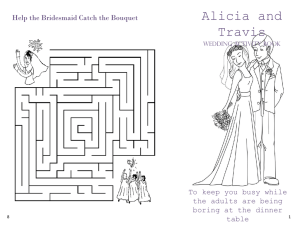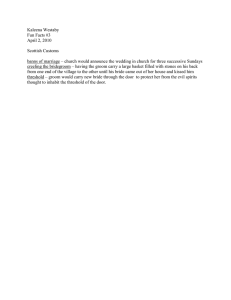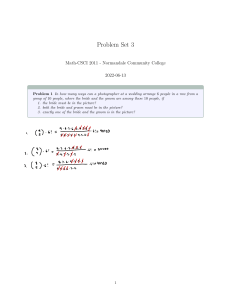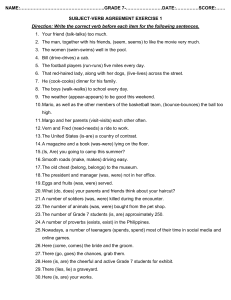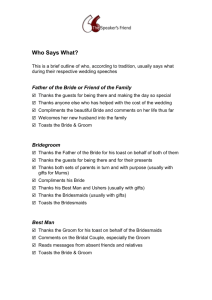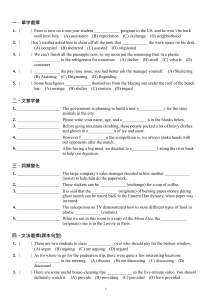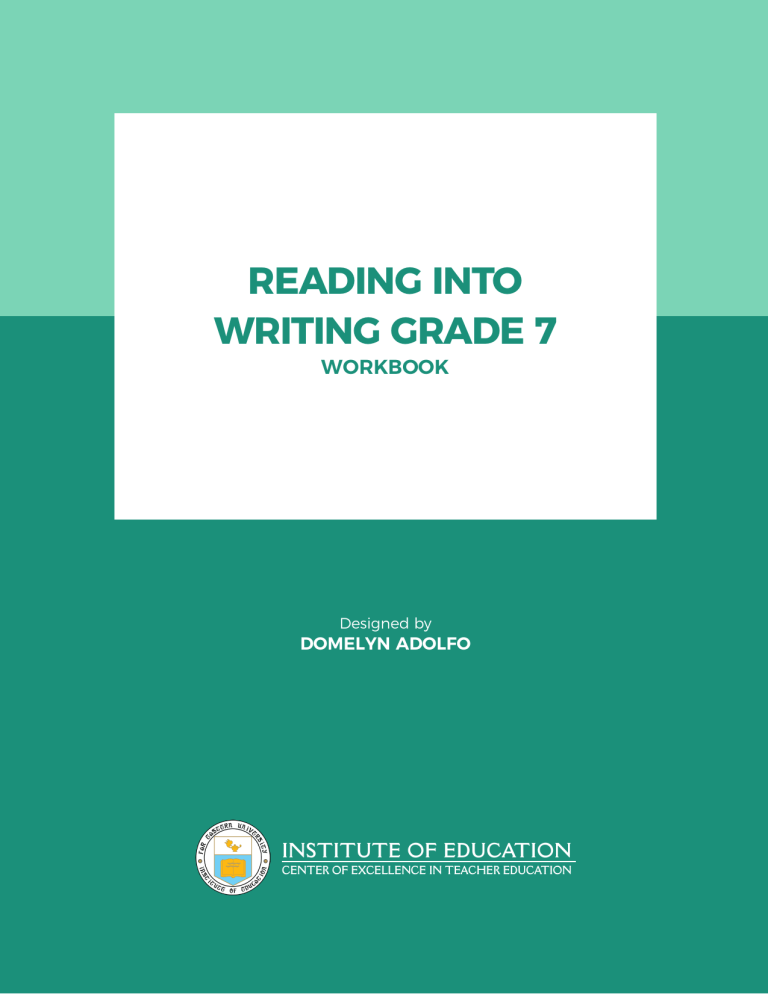
READING INTO WRITING GRADE 7 WORKBOOK Designed by DOMELYN ADOLFO INSTITUTE OF EDUCATION CENTER OF EXCELLENCE IN TEACHER EDUCATION I. Introduction Hey grade 7 studs! this workbook is designed to develop your communicative competence and for you to have a deeper appreciation of Philippine Literature. To make sure that learning goals are achieved, the writer designed activities and worksheets using reading into writing strategy. Learn English and appreciate Philippine Literature! II . Learners Grade 7 students belong to the generation born in a highly diverse computer environment. Apparently, they are also the generation who are adept to multi-tasking. Nevertheless, they need to develop effective reading and writing skills in either face to face or virtual communication. III. Learning Competencies 1. Extract information from a text using a summary, precis, and paraphrase 2. Use the passive and active voice meaningfully in varied contexts 3. Analyze relationships presented in analogies 4. Discover the conflicts presented in literary selections and the need to resolve those conflicts in non-violent ways INSTITUTE OF EDUCATION CENTER OF EXCELLENCE IN TEACHER EDUCATION I 2 LEARNING OUTCOMES A. Knowledge 1. Differentiate summarizing from paraphrasing. 2. Identify the rules and subject-verb agreement of using passive and active voice in writing sentences. 3. Identify the relationships in analogies 4. Determine the conflict and the kind of conflict encountered by the main character of epic. B. Skills 1. Construct sentences using passive and active voice correctly 2. Create a folktale observing the rules of passive and active voice of the verb. 3. Summarize the plot of the story through a graphic organizer. 4. Paraphrase ideas presented in text and other contents correctly C. Attitude 1. Value the importance of summarizing and paraphrasing as effective writing skills. 2. Appreciate the value of analyzing analogies in critical thinking. IV. Introduction A. Philippine Literature reflects the diverse literary works from the precolonial times, during colonial times and up to the present society. It includes folktales, social and political, and real-life experiences in different milieu. Pre-Hispanic literature was passed from generation to generation orally and not until colonial times that written literature started. Epic is a long narrative poem that narrates the heroic adventures of a legendary man. In Philippine literature, epic is in chants or song and it is episodic. Most of the times, it includes supernatural characters that help the main character. INSTITUTE OF EDUCATION CENTER OF EXCELLENCE IN TEACHER EDUCATION I 3 READING TEXT Tuwaang is an epic hero in several epics of the indigenous group Bagobo in Mindanao. Tuwaang (Epic of Bagobo) Tuwaang received a message of invitation from the wind saying that he should attend the long- waited wedding of the Dalaga ng Monawon. Don’t go, Tuwaang, his aunt warned him. I feel that something wrong is going to happen to you there. Don’t worry, tiyang. I can take care of myself! he said firmly, determined to go. You don’t understand me, Tuwaang. I’m not afraid of anything, tiyang. Right now, all I ever want is to have a glimpse of the beauty of the Dalaga ng Monawon. Tuwaang did not listen to his aunt. He insisted to go and prepared to attend the grand wedding. He wore the clothes the goddesses made for him. He got the heart-shaped basket that could make the lightning move. He took along with him his sharp spear and shield and the long knife. He rode in the lightning and he soon reached the beautiful boundless plain of Kawkawangan. There, he found a Gungutan, a bright colored bird that could talk. The bird wanted to go with him to the grand wedding so he took it along with him. When they reached the town of Monawon, they were politely let into the hall where the wedding would take place. The guests started coming one by one. First to come was the young Binata ng Panayangan, then the charming Binata ng Sumisikat na Araw. Last to come was the groom, the Binata ng Sakadna who was with his one hundred well trained men. INSTITUTE OF EDUCATION CENTER OF EXCELLENCE IN TEACHER EDUCATION I 4 As soon as he arrived, the groom ordered all his men to drive away the guests who should not be there or those uninvited guests. Insulted, Tuwaang told the groom that they, the guests were all pulang dahon, which meant heroes. In short time, the ceremony started with the guests being offered several precious things that they should top with what they had. Two were left for the groom but the Binata ng Sakadna admitted that he didn’t have a gold flute and a gold guitar to top what were left. Tuwaang came to the quick rescue. With his mysterious breath, he produced a gold flute, guitar and gong. The beautiful bride came out of her room and started offering a bowl containing nganga to every guest. Then she sat beside Tuwaang that put the groom in a very embarrassing situation. The groom felt insulted. He went out the hall and challenged Tuwaang to a fight. Show me that you deserved the honor my lady bestowed upon you by sitting next to you! the Binata ng Sakadna angrily challenged him. Fight me to death! Tuwaang slowly stood to accept the challenge but the beautiful bride held his hand. Let me just comb your hair before you fight him, the bride told Tuwaang in a soft whisper. And she lovingly combed his hair. Tuwaang glanced and stared at the bride. He saw love and admiration for him in her eyes. “Take extra care when you face him, the bride warned him. He does not fight squarely.” Tuwaang took her hand and brought it gently to his mouth and kissed it. For you, my lady, I’ll be careful! he said and came out of the hall to face the groom. The bride nodded and waved her hand to him, wishing him the best. Tuwaang and the Gungutan faced the Binata ng Sakadna and his one hundred well trained men. He fought fiercely with all his might and after INSTITUTE OF EDUCATION CENTER OF EXCELLENCE IN TEACHER EDUCATION I 5 a brief struggle, he and the Gungutan had killed ninety-four of the groom’s men. With less effort, they subdued the remaining six men until he and the Binata ng Sakadna were the only ones left standing. The groom hurled a big stone at Tuwaang but the stone turned into dust before it hit him. Because of the intensity of the struggle, the earth shook and every tree fell down. The groom grabbed Tuwaang and threw him heavily on the ground. He sank on the ground and reached Hades. In Hades, Tuwaang saw Tuhawa, the god of Hades. Tuhawa told him that the life of the groom was in the gold flute. Tuwaang emerged from the ground and killed the groom by buying the gold flute. The bride ran to him happily. He embraced her and kissed her on her cheeks and lips. Will you go with me? Tuwaang asked the bride. With all my heart, she answered. Tuwaang then went home to Kuaman with the bride and the Gungutan and they lived happily ever after. ACTIVITY 1 - VOCABULARY SKILLS Word Analogy An analogy compares two things that are mostly different from each other but have some traits in common. By showing a connection between two different things, writers help to explain something important about one thing by using a second thing you already know about. Example: Philippines: Filipino : : Spain : Spanish Directions: Analyze the relationship of the ideas in each number. Fill in the blank with the correct word which has similar relationship with the first two words. INSTITUTE OF EDUCATION CENTER OF EXCELLENCE IN TEACHER EDUCATION I 6 1. bride : groom:: ____________ : father 2. wedding : guest:: ____________ : defender 3. trouble : rescue:: ____________ : play 4. weapon : spear ____________ : hero 5. hair : combing ____________ : playing 6. marriage : love ____________ : weapon 7. ground : Hades ____________ : heaven 8. bride : Dalaga ____________ : Tuwaang 9. hand : hold ____________ : kiss 10. head : nod ____________ : wave ACTIVITY 2 - COMPREHENSION CHECK Directions: Make sure that you have read and understand the reading text. Read each question carefully and encircle the correct answer. 1. Tuwaang insisted to attend the wedding of Dalagang Magawaon but his aunt didn’t agree. What did she tell him about the wedding? A. She knew that the Binata ng Sakadna with his 100 trained men would be there. B. She wanted to go with Tuwaang but she didn’t receive an invitation C. She sensed that Tuwaang would be harmed in the wedding. D. She didn’t like the Dalaga ng Manawon for Tuwaang. 2. Based on the epic, Tuwaang didn’t obey his aunt but instead he left putting on the clothes that the goddesses made for him. Why do you think Tuwaang wanted to attend the wedding? A. He wanted to wear the clothes that the goddesses made for him. B. He wanted to stop the wedding of the Dalaga ng Manawon. C. He wanted to try his weapons by fighting with the groom. D. He wanted to see the beauty of the bride. INSTITUTE OF EDUCATION CENTER OF EXCELLENCE IN TEACHER EDUCATION I 7 3. In the story, the Binata of Sinakdana arrived with his 100 trained men and told the guests that they should go but Tuwaang replied to that they are all “ pulang dahon”, what does the word mean? A. uninvited guests B. heroes C. monarchs D. businessmen 4. Before Tuwaang went to the wedding, he gathered all his weapons including the heart-shaped basket. What was the power of a heart shape basket as described in the story? A. It could move a lightning. B. It could make the sun shines. C. It could fall heavy rains. D. It could cause a thunder. 5. When the beautiful bride came out of her room, the Binata ng Sakadna challenged Tuwaang for a fight, what was his reason? A. He was threatened by Tuwaang’s weapons. B. He was jealous of the bride’s fondness to Tuwaang. C. Binata ng Panyangan and Binata ng Sumisikat ng araw told him to. D. The bride arranged the two of them for a combat. 6. In the story, who helped Tuwaang on how to kill the groom? A. Binata ng Panayangan B. Dalaga ng Manawon C. Gungutan D. Tuhawa INSTITUTE OF EDUCATION CENTER OF EXCELLENCE IN TEACHER EDUCATION I 8 7. Of all the four potential men in the wedding including the groom, why did the bride show interest to Tuwaang? A. She saw him helping the Binata ng Sakadna B. She saw him fighting with Binata ng Sakadna. C. She was impressed by his weapons and his bird friend. D. She was impressed by Tuwaang eating nganga. 8. How did Tuwaang win the Dalaga of Monawon’s heart for marriage? A. fighting with the groom B. rescuing her from the Hades C. offering her the best gifts D. seeing his supernatural abilities 9. Why do think Binata ng Sakada took with him his 100 trained men in the wedding? A. He intended to impress his bride. B. He prepared for the battle against Tuwaang. C. He wanted to threaten the wedding guests. D. He tried to protect the bride and guests from attack. 10. After reading the epic, what Filipino characteristic Tuwaang represented? A. Bravery B. Righteousness C. Generous D. Compassion INSTITUTE OF EDUCATION CENTER OF EXCELLENCE IN TEACHER EDUCATION I 9 ACTIVITY 3 - WRITING SKILLS Take note of this! Summarizing – putting in your own word a shorter version of a text. Graphic Organizer – is a visual tool to show a relationship of ideas. To summarize a story, story map is used. Directions: Summarize the epic of Tuwaang by filling out the graphic organizer below. Name: _____________________________________ Date: ___________ Grade: ___________ Story Summary Title: ________________________________________________________ Genre: ________________________________________________________ Summarize the plot story in five sentences _____________________________________________________________________________ _____________________________________________________________________________ _____________________________________________________________________________ _____________________________________________________________________________ The main character of the story in five sentences _____________________________________________________________________________ _____________________________________________________________________________ _____________________________________________________________________________ _____________________________________________________________________________ The writer’s purpose of writing the story _____________________________________________________________________________ _____________________________________________________________________________ _____________________________________________________________________________ _____________________________________________________________________________ INSTITUTE OF EDUCATION CENTER OF EXCELLENCE IN TEACHER EDUCATION I 10 ACTIVITY 4 - WRITING SKILLS Take note of this! Paraphrasing – rewriting the ideas using your own words for better understanding How to paraphrase a text: • Describe the important ideas using your own words one by one. • Check the text and the paraphrased version for any similarities. Focus on the main ideas. • List the substitute words for main ideas. Make sure to change the structure of the sentence. • Do not adjust special words especially those considered as common words. Rubrics for Paraphrasing: see attachment Practice 1: Original Text “I’m not afraid of anything, tiyang. Right now, all I ever want is to have a glimpse of the beauty of the Dalaga ng Monawon.” Paraphrased Version “Nothing can make me afraid. Tiyang. I badly need to see the beauty of the Dalaga ng Manawon at this moment” Independent Practice: 1. Tuwaang did not listen to his aunt. He insisted to go and prepared to attend the grand wedding. He wore the clothes the goddesses made for him. He got the heart-shaped basket that could make the lightning move. He took along with him his sharp spear and shield and the long knife. _____________________________________________________________________________ _____________________________________________________________________________ _____________________________________________________________________________ _____________________________________________________________________________ INSTITUTE OF EDUCATION CENTER OF EXCELLENCE IN TEACHER EDUCATION I 11 2. The beautiful bride came out of her room and started offering a bowl containing nganga to every guest. Then she sat beside Tuwaang that put the groom in a very embarrassing situation. The groom felt insulted. He went out the hall and challenged Tuwaang to a fight. _____________________________________________________________________________ _____________________________________________________________________________ _____________________________________________________________________________ _____________________________________________________________________________ 3. For you, my lady, I’ll be careful! he said and came out of the hall to face the groom. The bride nodded and waved her hand to him, wishing him the best. _____________________________________________________________________________ _____________________________________________________________________________ _____________________________________________________________________________ _____________________________________________________________________________ 4. In Hades, Tuwaang saw Tuhawa, the god of Hades. Tuhawa told him that the life of the groom was in the gold flute. Tuwaang emerged from the ground and killed the groom by buying the gold flute. The bride ran to him happily. He embraced her and kissed her on her cheeks and lips. _____________________________________________________________________________ _____________________________________________________________________________ _____________________________________________________________________________ _____________________________________________________________________________ 5. Tuwaang then went home to Kuaman with the bride and the Gungutan and they lived happily ever after. _____________________________________________________________________________ _____________________________________________________________________________ _____________________________________________________________________________ _____________________________________________________________________________ INSTITUTE OF EDUCATION CENTER OF EXCELLENCE IN TEACHER EDUCATION I 12 ACTIVITY 5 - LITERARY FOCUS Take note of this! Conflict – the struggle between two opposing forces usually it involves the protagonist and antagonist Types of Conflict 1. Person to Person -the character is fighting against another 2. Person vs Self – the character is struggling against his/her desires/selves 3. Person vs Fate (God)- the character is struggling against a situation that freedom might be impossible. 4. Person vs Nature – the character is fighting to survive 5. Person vs Society – the character is struggling against social injustices 6. Person vs Unknown (Extraterrestrial) -the character is battling against an entity 7. Person vs Technology – the character is fighting against an emotionless machines Practice 1 Directions: Read the story of Tuwaang again. Look for the conflict of the story and the resolution. Suggest a possible peaceful resolution for the conflict of the story. Fill in the information sheet below. Conflict Type of Conflict INSTITUTE OF EDUCATION CENTER OF EXCELLENCE IN TEACHER EDUCATION Resolution Possible Peaceful Resolution I 13 Independent Practice Directions: Cite a story from a book or a movie and identify its conflict, type of conflict and its resolution, and think of a possible peaceful resolution. Share it in class! Title Conflict Type of Conflict Resolution Possible Peaceful Resolution ACTIVITY 6 - GRAMMAR CHECK Take note of this! Passive and Active Voice of the Verb Active Voice – the subject of the sentence is the doer of the action and the subject is the receiver of the action. Most sentences are active. Format: Thing doing action] + [verb] + [thing receiving action] INSTITUTE OF EDUCATION CENTER OF EXCELLENCE IN TEACHER EDUCATION I 14 Example: Tuwaang attended the grand wedding together with his bird friend. Passive Voice - the receiver of the action is the subject of the sentence and the doer of the action is least important or the doer of the action is unknown. Format: [Thing receiving action] + [be] + [past participle of verb] + [by] + [thing doing action] Example: The grand wedding was attended by Tuwaang and other important guests. Practice 1 Directions: Read the sentences carefully and convert them in the passive voice of the verb. Observe correct subject-verb agreement. 1. Tuwaang wore the clothes made by the goddesses. ___________________________________________________________________ 2. The groom challenged Tuwang to a fight ___________________________________________________________________ 3. With his mysterious breath, Tuwaang produces a golden flute. ___________________________________________________________________ 4. Tuwaang and Dalaga ng Manawon are preparing for a grand wedding. ___________________________________________________________________ 5. Tuwaang and Gungutan won the several battles against the 100 trained men of the groom. ___________________________________________________________________ INSTITUTE OF EDUCATION CENTER OF EXCELLENCE IN TEACHER EDUCATION I 15 Practice 2 Directions: Read the sentences carefully and convert them in the active voice of the verb. Observe correct subject-verb agreement. 1. The grand festival was celebrated by people from different parts of the world. ___________________________________________________________________ 2. The poor people were given a temporary shelter during the pandemic. ___________________________________________________________________ 3. Folktales and short stories are read by people who are interested in literature. ___________________________________________________________________ 4. The pawned jewelries will be bought by a famous young actor. ___________________________________________________________________ 5. The building is designed by a famous architect from United Kingdom. ___________________________________________________________________ ACTIVITY 7 - WRITE IT UP! Now that you learned what an epic is and can identify the different elements of epic including conflict and types of conflict, it’s finally your turn to write your own story. Directions: Write an 500-700 word epic story. Review the elements of a fiction: character, setting, plot, point of view and conflict. Decide on each element. You may use a graphic organizer before writing your story. _____________________________________________________________________________ _____________________________________________________________________________ _____________________________________________________________________________ _____________________________________________________________________________ INSTITUTE OF EDUCATION CENTER OF EXCELLENCE IN TEACHER EDUCATION I 16 References 7 Types ofConflict in Literature (n.d) Retrieved from: https://www.scribendi.com/advice/ types_of_conflict_in_literature.en.html. June 20, 2020. Bowman J. (2019) Teaching students to paraphrase. Retrieved from: https://www. edutopia.org/article/teaching-students-paraphrase .June 18, 2020. Passive and active form of the verb. Retrieved from https://www.englishpage.com/ verbpage/activepassive.html. June 20, 2020. Tuwaang(Epic ng Bagobo). Retrieved from: https://www.kapitbisig.com/philippines/ bilingualtagalog-english-version-of- epicsmgaepiko-tuwaang-epic-of-bagobobilingual-tagalog english- version_794.html. June 18, 2020. Appendices Rubrics for Summary Criteria: Content- 25% Organization- 25% Voice- 25% Grammar and Mechanics- 25% Rubrics for Paraphrasing Criteria: Format- 25% Content- 25% Word choice and Structure-25% Mechanics- 25% Rubrics for Short Story Criteria: Use of Literary Devices- 20% Character Development- 20% Plot Development- 20% Conflict - 20% Mechanics and Grammar -20 % INSTITUTE OF EDUCATION CENTER OF EXCELLENCE IN TEACHER EDUCATION I 17
